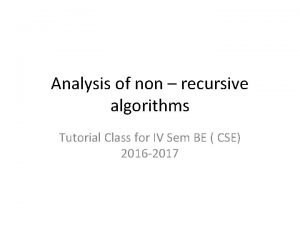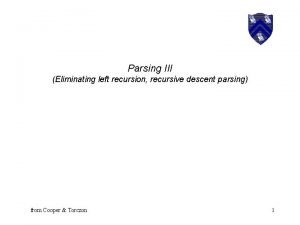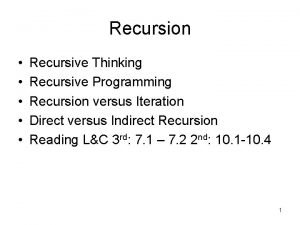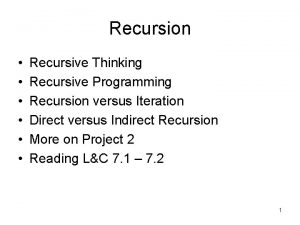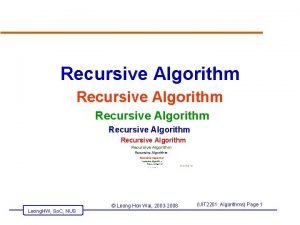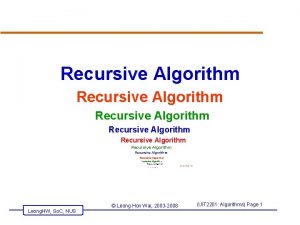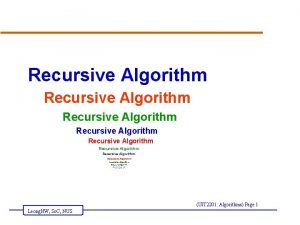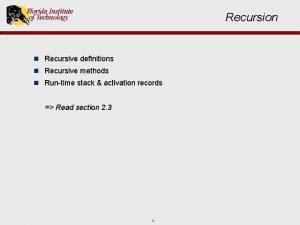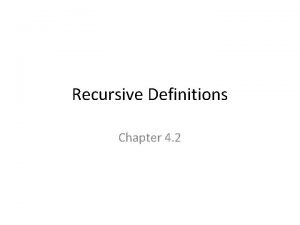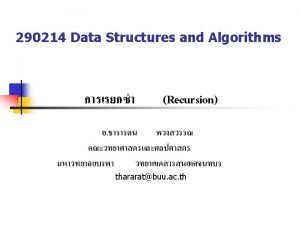Recursion Recursive Procedures 3 5 Recursion A way













- Slides: 13

Recursion

Recursive Procedures (§ 3. 5) • • • Recursion: A way of defining a concept where the text of the definition refers to the concept that is being defined. (Sounds like a buttery butter, but read on…) In programming: A recursive procedure is a procedure which calls itself. Caveat: The recursive procedure call must use a different argument that the original one: otherwise the procedure would always get into an infinite loop… Classic example: Here is the non-recursive definition of fhe factorial function: – n! = 1· 2· 3· ··· · (n-1)· n • Here is the recursive definition of a factorial: (here f(n) = n!) • Code of recursive procedures, in functional programming languages like Java, is almost identical to a recursive definition! Example: The Java code for the Factorial function: • // recursive procedure for computing factorial public static int Factorial(int n) { if (n == 0) return 1; // base case else return n * Factorial(n- 1); // recursive case }

Content of a Recursive Method • Base case(s). – Values of the input variables for which we perform no recursive calls are called base cases (there should be at least one base case). – Every possible chain of recursive calls must eventually reach a base case. • Recursive calls. – Calls to the current method. – Each recursive call should be defined so that it makes progress towards a base case.

Visualizing Recursion • Recursion trace • A box for each recursive call • An arrow from each caller to callee • An arrow from each callee to caller showing return value Example recursion trace: return 4*6 = 24 call final answer recursive. Factorial(4) return 3*2 = 6 call recursive. Factorial(3) return 2*1 = 2 call recursive. Factorial(2) call return 1*1 = 1 recursive. Factorial(1) call recursive. Factorial(0) return 1

Linear Recursion (§ 3. 5. 1) • Test for base cases. – Begin by testing for a set of base cases (there should be at least one). – Every possible chain of recursive calls must eventually reach a base case, and the handling of each base case should not use recursion. • Recur once. – Perform a single recursive call. (This recursive step may involve a test that decides which of several possible recursive calls to make, but it should ultimately choose to make just one of these calls each time we perform this step. ) – Define each possible recursive call so that it makes progress towards a base case.

A Simple Example of Linear Recursion Algorithm Linear. Sum(A, n): Input: A integer array A and an integer n = 1, such that A has at least n elements Output: The sum of the first n integers in A if n = 1 then return A[0] else return Linear. Sum(A, n - 1) + A[n - 1] Example recursion trace: call return 15 + A[4] = 15 + 5 = 20 Linear. Sum (A, 5) call return 13 + A[3] = 13 + 2 = 15 Linear. Sum (A, 4) call return 7 + A[2] = 7 + 6 = 13 Linear. Sum (A, 3) call return 4 + A[1] = 4 + 3 = 7 Linear. Sum (A, 2) call Linear. Sum (A, 1) return A[0] = 4

Reversing an Array Algorithm Reverse. Array(A, i, j): Input: An array A and nonnegative integer indices i and j Output: The reversal of the elements in A starting at index i and ending at j if i < j then Swap A[i] and A[ j] Reverse. Array(A, i + 1, j - 1) return

Defining Arguments for Recursion • In creating recursive methods, it is important to define the methods in ways that facilitate recursion. • This sometimes requires we define additional paramaters that are passed to the method. • For example, we defined the array reversal method as Reverse. Array(A, i, j), not Reverse. Array(A).

Computing Powers • The power function, p(x, n)=xn, can be defined recursively: • This leads to an power function that runs in O(n) time (for we make n recursive calls). • We can do better than this, however.

Recursive Squaring • We can derive a more efficient linearly recursive algorithm by using repeated squaring: • For example, 24 = 2(4/2)2 = (22)2 = 42 = 16 25 = 21+(4/2)2 = 2(22)2 = 2(42) = 32 26 = 2(6/ 2)2 = (26/2)2 = (23)2 = 82 = 64 27 = 21+(6/2)2 = 2(23)2 = 2(82) = 128.

A Recursive Squaring Method Algorithm Power(x, n): Input: A number x and integer n = 0 Output: The value xn if n = 0 then return 1 if n is odd then y = Power(x, (n - 1)/ 2) return x · y ·y else y = Power(x, n/ 2) return y · y

Analyzing the Recursive Squaring Method Algorithm Power(x, n): Input: A number x and integer n = 0 Output: The value xn if n = 0 then return 1 if n is odd then y = Power(x, (n - 1)/ 2) return x · y else y = Power(x, n/ 2) return y · y Each time we make a recursive call we halve the value of n; hence, we make log n recursive calls. That is, this method runs in O(log n) time. It is important that we used a variable twice here rather than calling the method twice.

Tail Recursion • Tail recursion occurs when a linearly recursive method makes its recursive call as its last step. • The array reversal method is an example. • Such methods can be easily converted to nonrecursive methods (which saves on some resources). • Example: Algorithm Iterative. Reverse. Array(A, i, j ): Input: An array A and nonnegative integer indices i and j Output: The reversal of the elements in A starting at index i and ending at j while i < j do Swap A[i ] and A[ j ] i =i+1 j =j-1 return
 Recursive and non recursive algorithm
Recursive and non recursive algorithm Left recursion and left factoring
Left recursion and left factoring To understand recursion you must understand recursion
To understand recursion you must understand recursion Walk this way talk this way
Walk this way talk this way Explain threaded binary tree in data structure
Explain threaded binary tree in data structure Contoh soal uji two way anova
Contoh soal uji two way anova Perbedaan anova one way and two way
Perbedaan anova one way and two way Conventional software engineering
Conventional software engineering Frequency trig
Frequency trig Anova hypothesis examples
Anova hypothesis examples The one was a ship
The one was a ship Two way anova
Two way anova One way anova vs two way anova
One way anova vs two way anova Procedures in visual basic
Procedures in visual basic
